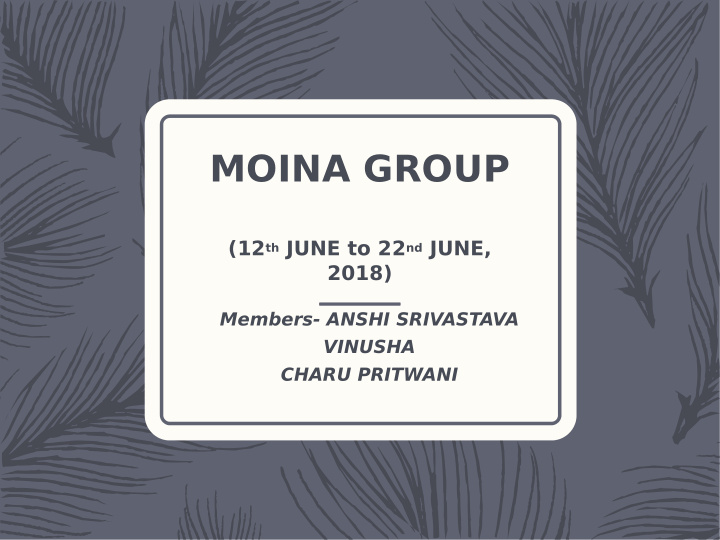



MOINA GROUP (12 th JUNE to 22 nd JUNE, 2018) Members- ANSHI SRIVASTAVA VINUSHA CHARU PRITWANI
MODEL ORGANISM MOINA Moina are small insects from crustaceous sub-phylum. They appear in high numbers in pools, ponds, lakes, ditches,etc. Moina feed on various groups of bacteria, yeast, phytoplankton .Bacterial and fungal cells rank high in food value. The brood pouch, where the eggs and embryos develop, is on the dorsal side of the female. Moina have an open pouch.
Why Moina as a model organism? Moina are generally quite tolerant of poor water quality. They live in water where the amount of dissolved oxygen varies from almost zero to supersaturation. Moina are particularly resistant to changes in the oxygen concentration. The ability to survive in oxygen-poor environments is due to their capacity to synthesize haemoglobin, due to which they appear red. Haemoglobin formation is dependent on the level of dissolved oxygen in the water. The production of haemoglobin may also be caused by high temperature and high population density. Moina is an emerging epigenetic model organism.
OBJECTIVE:- * T o obtain red moina from colourless moina in the cup culture by providing hypoxic condition. * T o retain the red colour of red moina by adding valproic acid(VPA) in difgerent concentrations.
EXPERIMENTAL SETUP SETUP 1:(colourless to red)- 10 culture cups with replicates, each cup having -200 ml DC water -6 colourless moinas - milk drops added in difgerent concentrations from 1 to 10 drops. SETUP 2(retain red to red):- 5 culture cups with replicates, each cup having -200 ml DC water -5 red moinas. - 1 drop milk is added on daily basis - Valproic acid is added on difgerent concentrations from 10 mg to 50 mg. CONTROL :- - 200 ml DC water - 5 red moinas - 1 drop milk added on daily basis and contains no VPA.
EXPECTED VALUES SETUP 1 :- We expected colour change in higher concentration of milk drops such as in 7 drops on 3 rd day. REASON:- As we increase the concentration of milk dropwise, bacterial growth is increased and therefore it creates a hypoxic condition for moina to change colour . SETUP 2:- We expected red moinas to retain it's red colour when VPA was added and in control red moina are changed to colourless. REASON:- Valproic acid acts as the HDAC inhibitor and doesn’t allow deacetylation to occur at histone.
OBSERVATION 1 st SETUP:- ( COLOURLESS TO RED MOINAS) We observed red moinas on 2 and 3 drop milk culture on 6 th day and the moinas above 4 drops were dying eventually from 2 nd day(48 hours). 2 nd SETUP:- ( RETAIN RED TO RED) In control, moinas turned red to colourless in 48 hrs where as in other cup cultures containing VPA acid were found dead in 48 hrs.
DIFFERENCE BETWEEN COLOURLESS AND RED MOINA COLOURLESS MOINA RED MOINA
moina graph 80 70 60 1 drop A 50 2 drop B 3 drop C 4 drop D 5 drop E 40 no.of moina 6 drop F 7 drop G 8 drop H 9 drop I 30 10 drop J 20 10 0 43263 43264 43265 43266 43267 43268 43269 43270 43271 43272 date
GOOF UPS:- The number of moinas we added were less in number and we didn’t check whether they were adults or progeny. It is possible that they must have completed their life span and were dying. We should have made more than 1 replica for each setup to conclude any result. Milk was fed to moinas by difgerent people so the concentration of milk added to each cup would have varied. We didn’t maintain log book for DC water. May be the DC water was too old and must have got contaminated by the chemicals in the lab. While preparing setup for VPA , we were adding difgerent volume of VPA to each 200ml cup and the total volume in each cup was difgerent on adding VPA.
REFERENCE – Heterogenity and differential gene expression under hypoxia was cited by kimura and Yamagata, University of Pharmacy and Life Science, Tokyo Japan published in 1999, April. – Hypoxia-induced Synthesis of Hb is Hypoxia-inducible Factor- dependent by Thomas A. Gorr and Joshua D. Cahn of Department of Medicine, Massachusetts. – Martin Gottlicher, Institute of Toxicology and Genetics defined VPA as HDAC inhibitor and it was published in EMBO J. in Dec 2001.
Thank You
Recommend
More recommend